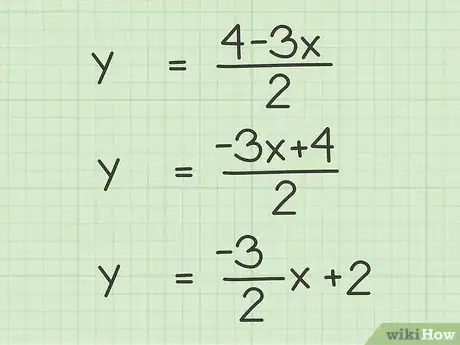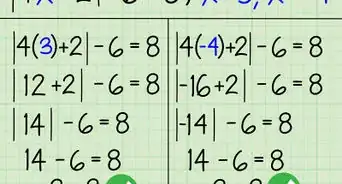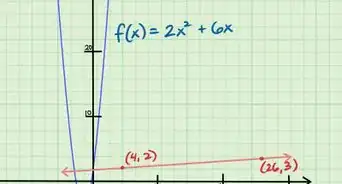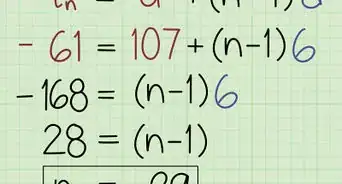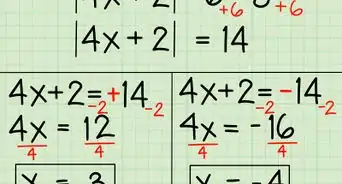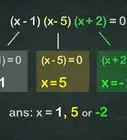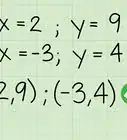This article was co-authored by wikiHow Staff. Our trained team of editors and researchers validate articles for accuracy and comprehensiveness. wikiHow's Content Management Team carefully monitors the work from our editorial staff to ensure that each article is backed by trusted research and meets our high quality standards.
There are 7 references cited in this article, which can be found at the bottom of the page.
This article has been viewed 82,119 times.
Learn more...
A literal equation is an equation that has all variables or multiple variables. To solve a literal equation, you need to solve for a determined variable by using algebra to isolate it.[1] You will often need to do this when rearranging geometric formulas or when solving linear equations. In order to solve literal equations, use the same algebraic principles you would use to solve linear equations.
Steps
Rearranging Geometric Formulas
-
1Determine which variable you need to isolate. Isolating a variable means getting the variable on one side of an equation by itself. This information should be given to you, or you can figure it out based on what information you know you will be given.[2]
- For example, you might be told to solve the area of a triangle formula for . Or, you might know that you have the area and base of the triangle, so you need to solve for the height. So, you need to rearrange the formula and isolate the variable.
-
2Use algebra to solve for the desired variable. Use inverse operations to cancel variables on one side of the equation and move them to the other side. Keep in mind the following inverse operations:
- Multiplication and division.
- Addition and subtraction.
- Squaring and taking a square root.
Advertisement -
3Keep the equation balanced. Whatever you do to one side of the equation, you must also do to the other side. This ensures that your equation remains true, and in the process you are moving variables from one side to the other as needed.
- For example, to solve the area of a triangle formula () for :
- Cancel the fraction by multiplying each side by 2:
- Isolate by dividing each side by :
- Cancel the fraction by multiplying each side by 2:
- Rearrange the formula, if desired:
- For example, to solve the area of a triangle formula () for :
Rearranging Equations of Lines
-
1Remember the slope-intercept form for the equation of a line. The slope-intercept form is , where equals the y-coordinate of a point on the line, equals the x-coordinate of that same point, equals the slope of the line, and equals the y-intercept.[3]
-
2Remember the standard form of a line. The standard form is , where and are the coordinates of a point on the line, is a positive integer, and and are integers.[4]
-
3Use algebra to isolate the appropriate variable. Use inverse operations to move variables from one side of the equation to the other side. Remember to keep the equation balanced, which means that whatever you do to one side of the equation, you must also do to the other side.[5]
- For example, you might have the equation of a line . This is in standard form. If you need to find the y-intercept of the line, you need to rearrange the formula to slope-intercept form by isolating the variable:[6]
- Subtract from both sides of the equation:
. - Divide both sides by :
- Subtract from both sides of the equation:
- For example, you might have the equation of a line . This is in standard form. If you need to find the y-intercept of the line, you need to rearrange the formula to slope-intercept form by isolating the variable:[6]
-
4Reorder the variables and constants, if necessary. If you are changing an equation to slope-intercept or standard form, rearrange the variables, coefficients, and constants so that they follow the correct formula.[7]
- For example, to change to the correct slope-intercept formula, you need to switch the order of the number in the numerator, then simplify:
Now, since the formula is in proper slope-intercept form, it is easy to identify the y-intercept as 2.
- For example, to change to the correct slope-intercept formula, you need to switch the order of the number in the numerator, then simplify:
Solving Sample Problems
-
1Solve this equation for . .
- Factor out the : .
- Isolate the by dividing each side by the expression in parentheses:
-
2Solve the circumference of a circle formula for the radius. The formula is [8]
- Understand what each variable stands for. In this formula, is the circumference, and is the radius. So you need to isolate the to solve for the radius.
- Isolate the by dividing both sides of the equation by :
- If desired, reverse the order of the equation for standard form: .
-
3Rewrite this equation of a line in standard form.
- Recall that standard form is .
- Cancel the fraction by multiplying each side of the equation by 2:
- Subtract from both sides of the equation:
- Rearrange the and variables so that they are in the standard form: .
- Multiply both sides by , since should be a positive integer for standard form:[9]
Community Q&A
-
QuestionHow do I solve 3x + w - r = y?
 DonaganTop AnswererBecause you're working with four variables, you would need a total of four separate equations, each containing those variables, in order to find their values.
DonaganTop AnswererBecause you're working with four variables, you would need a total of four separate equations, each containing those variables, in order to find their values. -
QuestionIn the equation Perimeter = 2(L + W), what is L?
 DonaganTop AnswererL is the length of whatever figure you're working with.
DonaganTop AnswererL is the length of whatever figure you're working with. -
QuestionFor the equation 12am = 4, how do I solve for a?
 DonaganTop AnswererDivide both sides of the equation by 12m.
DonaganTop AnswererDivide both sides of the equation by 12m.
References
- ↑ https://www.chilimath.com/lessons/intermediate-algebra/literal-equations/
- ↑ https://www.purplemath.com/modules/solvelit.htm
- ↑ http://www.coolmath.com/algebra/08-lines/07-equations-of-lines-slope-intercept-form-01
- ↑ https://virtualnerd.com/algebra-1/linear-equations-solve/isolate-variables-formulas-examples/formulas-examples/isolate-variable-from-formula
- ↑ https://virtualnerd.com/algebra-1/linear-equations-solve/isolate-variables-formulas-examples/formulas-examples/isolate-variable-from-formula
- ↑ http://www.purplemath.com/modules/solvelit2.htm
- ↑ https://virtualnerd.com/algebra-1/linear-equations-solve/isolate-variables-formulas-examples/formulas-examples/isolate-variable-from-formula
- ↑ http://www.mathopenref.com/circumference.html
- ↑ http://www.algebralab.org/studyaids/studyaid.aspx?file=algebra1_5-5.xml
About This Article
To solve literal equations, start by rearranging the equation based on the value you're solving for. For example, if you're solving for the height in the equation A equals 1/2bh, multiply 1/2bh by 2 in order to cancel out the fraction and end up with the bh. Next, multiply the other side by 2 to get 2A equals bh, since you need to do the same operation on both sides to keep the equation balanced. Then, isolate the variable h by rewriting the equation as h equals 2A divided by b. To learn how to rearrange equations of a line, keep reading!





























